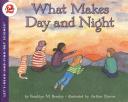What Makes Day and Night is a Stage 2 Let’s-Read-And-Find-Out Science book written by Franklyn M. Branley and illustrated by Arthur Dorros.
“The earth is always turning. It never stops. Round and round it goes. And it goes very fast. About 1000 miles an hour. As the earth turns we are always moving from day to night. And from night to day.”
“If you were on the moon, you would also have a day and night. But the moon spins very slowly, so days and nights are long. Places on the moon have two weeks of daylight and then two weeks of darkness.”
What Makes Day and Night is a great book that emphasizes the fact that day and night are caused by the rotation of the earth. The reader is shown some nice diagrams that illustrate this fact and there is a suggestion for students to do an experiment modeling night and day with a lamp. Along with simple text, the illustrations in What Makes Day and Night are nicely done and provide useful explanations for the topic. The last page of the book provides additional information and activity ideas for students to do that further discuss the topic of day and night and the earth’s rotation.
Curriculum Connections:
What Makes Day and Night obviously lends itself to discussion of day and night. It does a great job discussing the rotation of the earth and includes many illustrations of the earth as it looks from space. In Virginia, this topic is covered in the first grade and can be found in the Science Standards of Learning 1.6.
Additional Resources:
Day and Night Lesson Plan: This lesson plan includes a two day unit discussing the rotation of the earth and day and night with students. This lesson plan utilizes What Makes Day and Night to introduce the topic and has students perform an activity from the book in which they model day and night using a lamp. A worksheet is also available for this lesson.
Why do we have night?: This is a hands on lesson, using food to model the earth. Students will work in small groups to learn about the earth’s rotation and night and day.
NASA Lesson Plan: This lesson plan is nice because it is broken into two sections – a lesson for kindergarten and an extended lesson for first and second graders.
Rotating Earth: This animated earth goes from day to night and back again. Students have the ability to pause the animation to look at different parts of the earth.
Book Information:
Book: What Makes Day and Night
Author: Franklyn M. Branley
Illustrator: Arthur Dorros
Publisher: Collins
Publication Date: 1986
Pages: 32
Grade Range: K-3
ISBN-10: 0064450503
ISBN-13: 978-0064450508

